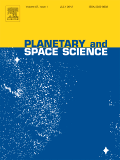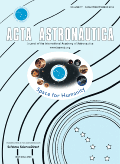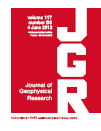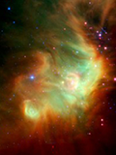
PLANETARY AND SPACE SCIENCE
Scope & Guideline
Transforming Perspectives: A Deep Dive into Cosmic Phenomena
Introduction
Aims and Scopes
- Planetary Geology and Geochemistry:
Research on the geological and geochemical processes that shape planetary bodies, including the study of surface materials, mineralogy, and geological history of planets such as Mars, Venus, and the Moon. - Astrobiology and Habitability:
Exploration of potential habitats for life beyond Earth, examining extreme environments on Earth as analogs for extraterrestrial conditions, and the implications for future missions. - Planetary Atmospheres and Climates:
Investigating the atmospheres of various celestial bodies, focusing on atmospheric composition, dynamics, and climatic processes, particularly in relation to Mars and Venus. - Impact Processes and Space Weathering:
Studying the effects of impacts on planetary surfaces, including cratering processes and the resulting geological features, as well as the implications of space weathering on surface materials. - Planetary Missions and Instrumentation:
A focus on the development and results of space missions, including the design and application of scientific instruments used for planetary exploration. - Exoplanetary Studies:
Research into the characteristics and detectability of exoplanets, often utilizing analogs from our Solar System to inform our understanding of distant worlds.
Trending and Emerging
- Machine Learning Applications:
The integration of machine learning techniques in analyzing planetary data is gaining traction, allowing for more efficient processing and interpretation of complex datasets. - In-Situ Resource Utilization (ISRU):
Research into ISRU technologies is on the rise, particularly in the context of lunar and Martian exploration, focusing on harnessing local materials for sustainable missions. - Planetary Defense and Near-Earth Object Studies:
Increased attention is being directed towards understanding and mitigating the risks posed by near-Earth objects, reflecting a growing global awareness of planetary defense. - Climate Change Analog Studies:
Studies using insights from Earth’s climate system to model and predict climate dynamics on other planets, particularly Mars, are becoming increasingly relevant. - Interdisciplinary Collaborations:
There is a notable trend towards interdisciplinary research, combining insights from geology, atmospheric science, and biology to create a more holistic understanding of planetary systems.
Declining or Waning
- Traditional Astrobiology:
While astrobiology remains important, traditional approaches focusing solely on Earth-like conditions for life are seeing less emphasis, with a shift towards broader definitions and the study of extremophiles. - Lunar Exploration Focus:
The intense focus on lunar studies, particularly those centered around historical missions, has waned as attention has shifted towards Mars and outer Solar System bodies. - Static Geological Studies:
There is a decline in purely observational geological studies that do not incorporate dynamic modeling or experimental validation, as the field moves towards more integrative approaches. - Meteorite Studies:
Research strictly focused on meteorites as isolated subjects is becoming less frequent, with more emphasis now placed on their implications for planetary formation and evolution.
Similar Journals

EARTH MOON AND PLANETS
Illuminating the Universe: Discoveries in Earth and Planetary SciencesEARTH MOON AND PLANETS, published by Springer, serves as a vital platform for researchers and professionals in the interdisciplinary fields of astronomy, planetary science, and earth sciences. With an ISSN of 0167-9295 and E-ISSN of 1573-0794, this journal has been disseminating knowledge since 1984 and continues to provide valuable insights into the complexities of celestial bodies and their interactions. Although currently ranked in the Q4 quartile across its relevant categories, including Astronomy and Astrophysics, Earth and Planetary Sciences, and Space and Planetary Science, the journal remains committed to fostering academic discourse and innovation in its field. Located in the Netherlands, at VAN GODEWIJCKSTRAAT 30, 3311 GZ DORDRECHT, the journal offers an array of research articles designed to inspire scholarly exploration and collaboration. Despite not providing open access options, it nevertheless plays a significant role in shaping the discourse around planetary research and is essential reading for anyone looking to deepen their understanding of earth, moon, and planetary sciences.

ACTA ASTRONAUTICA
Elevating the Standards of Aerospace ResearchACTA ASTRONAUTICA is a premier journal in the field of aerospace engineering, dedicated to advancing knowledge in space exploration and technology. Published by PERGAMON-ELSEVIER SCIENCE LTD in the United Kingdom, this journal boasts a prestigious Q1 ranking within its category as of 2023, positioning it in the top tier of aerospace engineering publications. With an ISSN of 0094-5765 and an E-ISSN of 1879-2030, ACTA ASTRONAUTICA has been a crucial resource for researchers and professionals since its inception in 1974, continuing to publish cutting-edge research through to 2024. The journal focuses on a wide range of topics, from orbital mechanics and spacecraft design to astronautics and planetary science, aiming to inspire innovation and facilitate the exchange of ideas among scholars, industry experts, and students. ACTA ASTRONAUTICA is ranked 19th out of 153 in its field, highlighting its importance and influence within the aerospace community. Researchers seeking a reputable platform to share their findings will find this journal to be an essential part of the academic discourse in aerospace engineering.

JOURNAL OF ASTROPHYSICS AND ASTRONOMY
Fostering Innovation in Celestial Research.JOURNAL OF ASTROPHYSICS AND ASTRONOMY, published by the Indian Academy of Sciences, stands as a pivotal resource for researchers and professionals in the fields of astrophysics and astronomy, with a rich history of publication dating back to 1980. This esteemed journal aims to disseminate high-quality research, fostering advancements in how we understand celestial phenomena, space environments, and planetary sciences. With a current Impact Factor that places it in the Q3 category for both Astronomy and Astrophysics and Space and Planetary Science, it maintains a crucial role in the global academic community, particularly within India. Although not an open access journal, its scholarly contributions are vital for both emerging and established researchers striving to push the boundaries of our knowledge in the cosmos. The journal is indexed in Scopus, ranking 56th in Astronomy and Astrophysics and 72nd in Space and Planetary Science, reflecting its ongoing significance and reach in the scientific dialogue.

Planetary Science Journal
Unlocking the Universe: Groundbreaking Insights in Planetary ScienceThe Planetary Science Journal, published by IOP Publishing Ltd in the United Kingdom, stands at the forefront of research in the fields of planetary science, astronomy, and geophysics. With its open access model established since 2020, this journal aims to democratize access to groundbreaking findings that explore the complex interactions between celestial bodies and their atmospheres, geology, and climates. Recognized for its high quality, the 2023 impact factor places the journal in the prestigious Q1 category across multiple disciplines, including Astronomy and Astrophysics, Earth and Planetary Sciences, and Space and Planetary Science. Ranked favorably among its peers, with notable scores in Scopus rankings, the journal seeks to contribute significantly to advancing our understanding of planetary systems and their formation, encouraging interdisciplinary collaboration among researchers, professionals, and students alike. By fostering a community of innovation and inquiry, the Planetary Science Journal is committed to publishing pioneering research that addresses critical questions of our universe.

Frontiers in Astronomy and Space Sciences
Advancing Knowledge Beyond the StarsFrontiers in Astronomy and Space Sciences is a leading open access journal published by FRONTIERS MEDIA SA, based in Switzerland. Since its inception in 2015, this journal has provided a dynamic platform for researchers, professionals, and students to disseminate their findings across a wide spectrum of topics within the field of astronomy and astrophysics. With an impressive 2023 Impact Factor reflecting its relevance and contribution to the scientific community, it ranks in the Q2 category in Astronomy and Astrophysics, demonstrating a solid reputation among peers. The journal's commitment to open access ensures that all published research is freely available, fostering greater collaboration and knowledge sharing among astronomers worldwide. With a diverse range of articles spanning from theoretical investigations to observational studies, Frontiers in Astronomy and Space Sciences is an essential resource for anyone seeking to explore the wonders of the universe and share innovative ideas that push the boundaries of our understanding.

Chinese Space Science and Technology
Transforming Ideas into Space SolutionsChinese Space Science and Technology is a pivotal journal dedicated to advancing the field of space engineering and technology, published by the esteemed Chinese Academy of Space Technology. With an ISSN of 1000-758X, this publication serves as a significant platform for cutting-edge research from China and around the globe, spanning vital intersections of Aerospace Engineering, Electrical and Electronic Engineering, and Materials Science. As evidenced by its Q3 ranking in 2023 across these categories, the journal consistently showcases innovative studies that contribute to the development of space technology, thereby impacting both theoretical frameworks and practical applications in the industry. Researchers and professionals will find valuable insights within its pages, while students can enrich their educational journey through its wealth of knowledge. Though primarily published in print, the journal continues to foster collaboration and engagement among the academic community, offering a glimpse into the future of space exploration and technological advancements through its relevant and timely content.

JOURNAL OF GEOPHYSICAL RESEARCH-SOLID EARTH
Illuminating the Foundations of Our PlanetJOURNAL OF GEOPHYSICAL RESEARCH-SOLID EARTH is a prestigious journal published by the American Geophysical Union, dedicated to advancing the study of solid Earth sciences. With an ISSN of 2169-9313 and E-ISSN of 2169-9356, it serves as a leading platform for rigorous research findings and innovative advancements within the fields of Earth and Planetary Sciences, Geochemistry and Petrology, Geophysics, and Space and Planetary Science. The journal has achieved an impressive Q1 quartile ranking across these categories, reflecting its high impact in the academic community and underscoring its role in influencing scientific discourse. Notably, it holds an esteemed position in Scopus, ranking 15th among 159 journals in Earth and Planetary Sciences (miscellaneous) as well as within the top 20 in several other geophysical domains. Researchers and practitioners are encouraged to contribute their work to this esteemed journal, which publishes comprehensive articles from 1979 to the present, thus providing a crucial repository of knowledge for those engaged in solid Earth research. Although it does not currently offer Open Access options, the journal's prestigious reputation ensures its articles reach a wide audience of academics, professionals, and students alike, fueling a deeper understanding of our planet's processes and challenges.

Annual Review of Earth and Planetary Sciences
Unlocking the Secrets of Our Planetary NeighborsAnnual Review of Earth and Planetary Sciences is a leading scholarly journal published by Annual Reviews, dedicated to advancing our understanding of the dynamic processes governing the Earth and its celestial companions. With ISSN 0084-6597 and E-ISSN 1545-4495, this esteemed journal, established in 1976, has consistently provided comprehensive reviews that synthesize cutting-edge research across various disciplines, including astronomy, astrobiology, geology, and planetary science. Notably, the journal has achieved a remarkable position in the academic landscape, ranking in the Q1 quartile across multiple categories, including Astronomy and Astrophysics and Earth and Planetary Sciences, with Scopus rankings placing it at the forefront of these fields. The journal's commitment to facilitating open access to critical scientific advances, though not fully open, allows for maximum reach within the research community. Researchers, professionals, and students alike can benefit from the high-impact articles designed to foster collaboration and innovation within the fields of earth and planetary science.

EARTH AND PLANETARY SCIENCE LETTERS
Driving Innovation in Geochemistry and GeophysicsEARTH AND PLANETARY SCIENCE LETTERS, published by ELSEVIER, stands as a premier academic journal in the fields of Earth and Planetary Sciences, Geochemistry and Petrology, Geophysics, and Space and Planetary Science. Since its inception in 1966 and continuing to 2024, the journal has consistently maintained an impressive reputation, ranking in the top quartile (Q1) across several categories, highlighting its vital role in advancing scholarly research. With a Scopus ranking of #4 in both Geophysics and Geochemistry and Petrology, and a notable 97th percentile in multiple Earth sciences categories, EARTH AND PLANETARY SCIENCE LETTERS provides a platform for groundbreaking research, encouraging rigorous investigation and dissemination of knowledge. While not available as an Open Access publication, the journal remains highly accessible to academics and professionals worldwide, providing invaluable insights and fostering discussions that influence the future of Earth sciences. Whether you are a researcher, educator, or student, this journal is a crucial resource for understanding our planet and its processes.

Earth and Space Science
Leading the Way in Earth and Space Research.Earth and Space Science, published by the American Geophysical Union, is a distinguished open-access journal that has profoundly impacted the realms of earth and planetary sciences as well as environmental science since its inception in 2014. With impressive rankings, including Q1 in both Earth and Planetary Sciences and Environmental Science for 2023, this journal ranks 38th out of 195 in the general Earth and planetary sciences category and 51st out of 219 in environmental science, showcasing its commitment to high-quality research dissemination. The journal serves as a vital platform for researchers, professionals, and students, fostering the exploration of critical topics and advancements within these pivotal fields. With an accessible format, researchers can benefit from the rich content available, furthering their knowledge and ensuring that groundbreaking discoveries reach a broader audience. The journal's ongoing commitment to open access aligns with contemporary trends in scholarly communication, emphasizing inclusion and collaboration in tackling pressing global challenges.